人教版(2019)高中英语选择性必修第二册 Unit5 First Aid Using Language(1) 名师教学设计
文档属性
| 名称 | 人教版(2019)高中英语选择性必修第二册 Unit5 First Aid Using Language(1) 名师教学设计 |
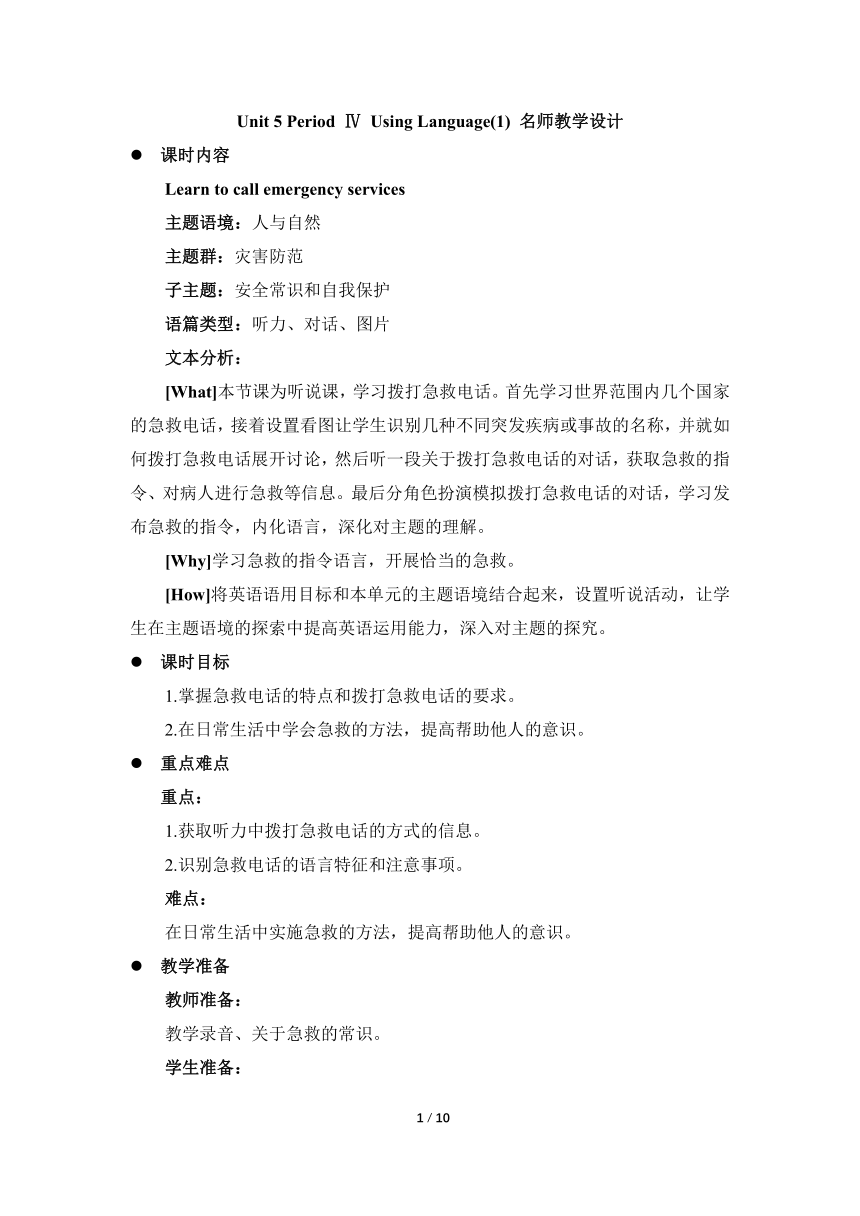
|
|
| 格式 | docx | ||
| 文件大小 | 2.1MB | ||
| 资源类型 | 教案 | ||
| 版本资源 | 人教版(2019) | ||
| 科目 | 英语 | ||
| 更新时间 | 2023-03-12 19:57:02 | ||
图片预览

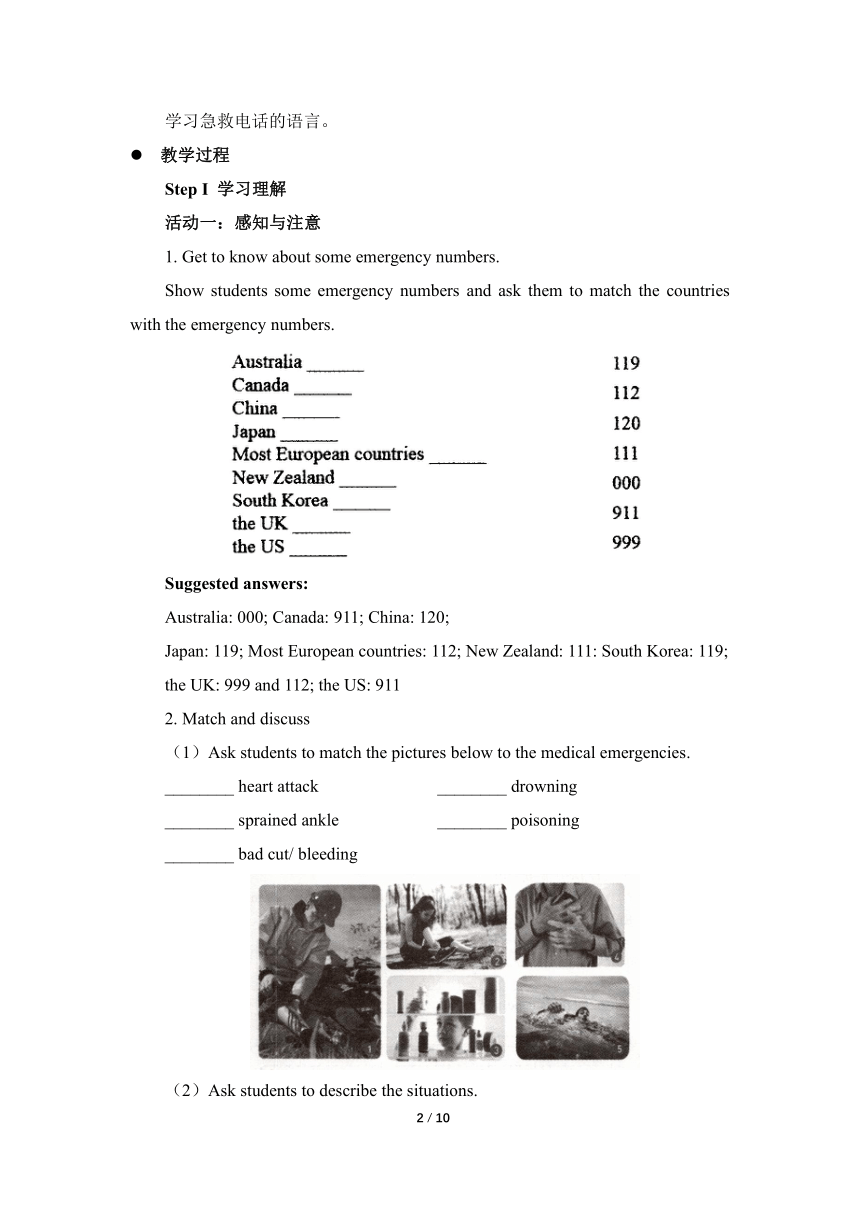
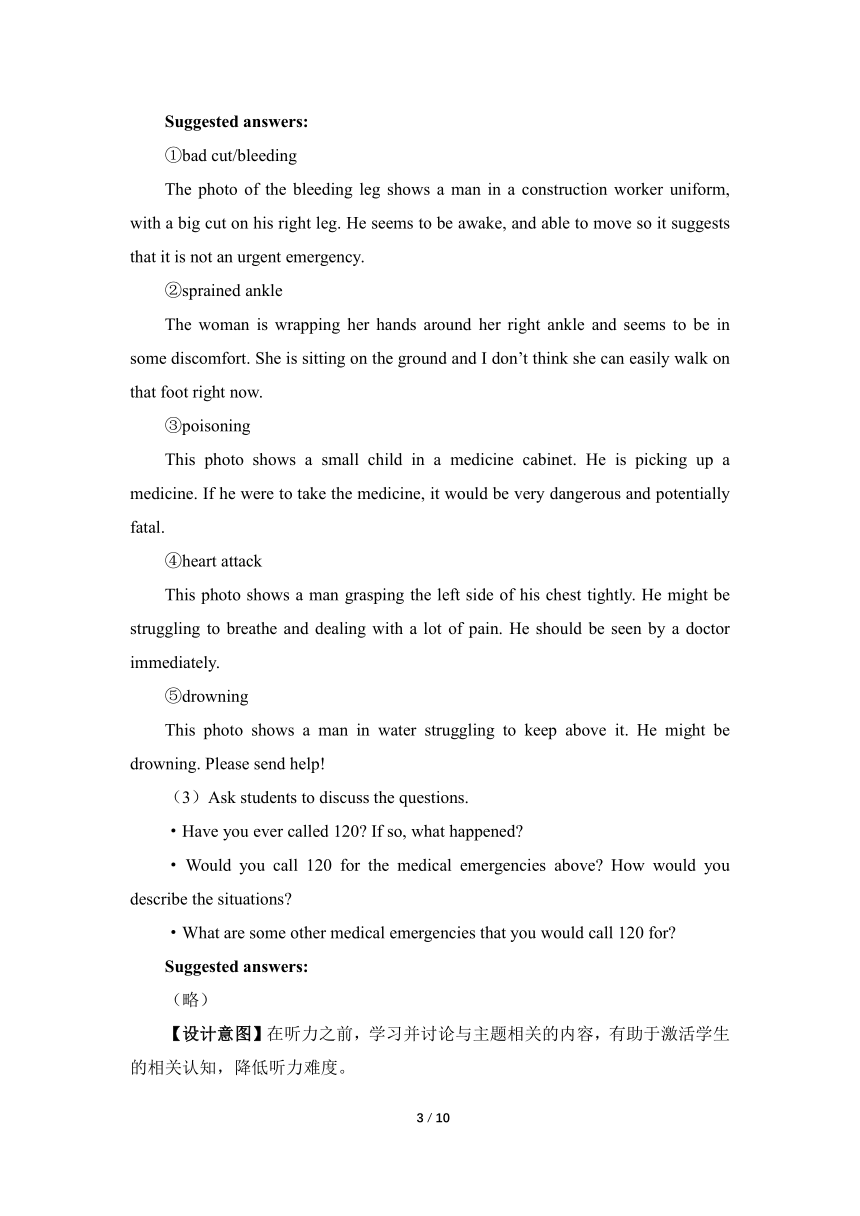
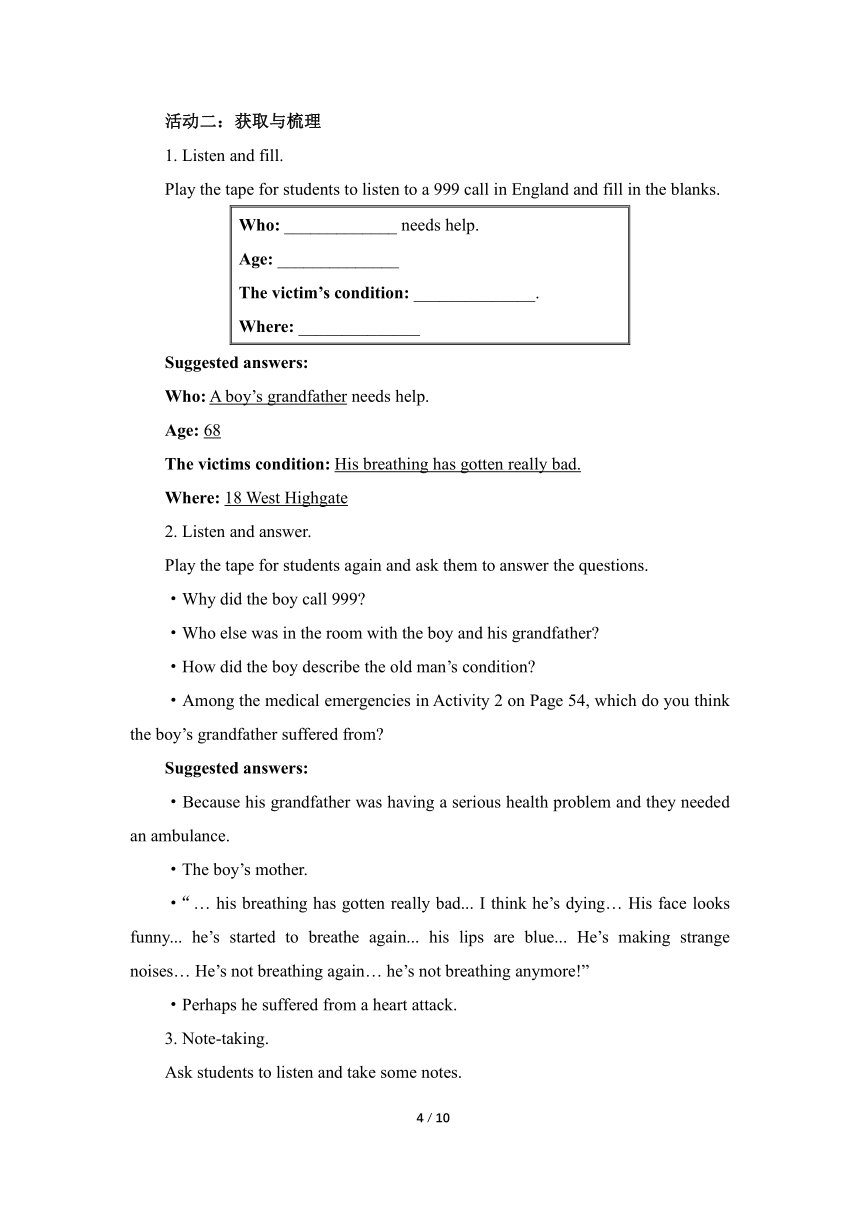
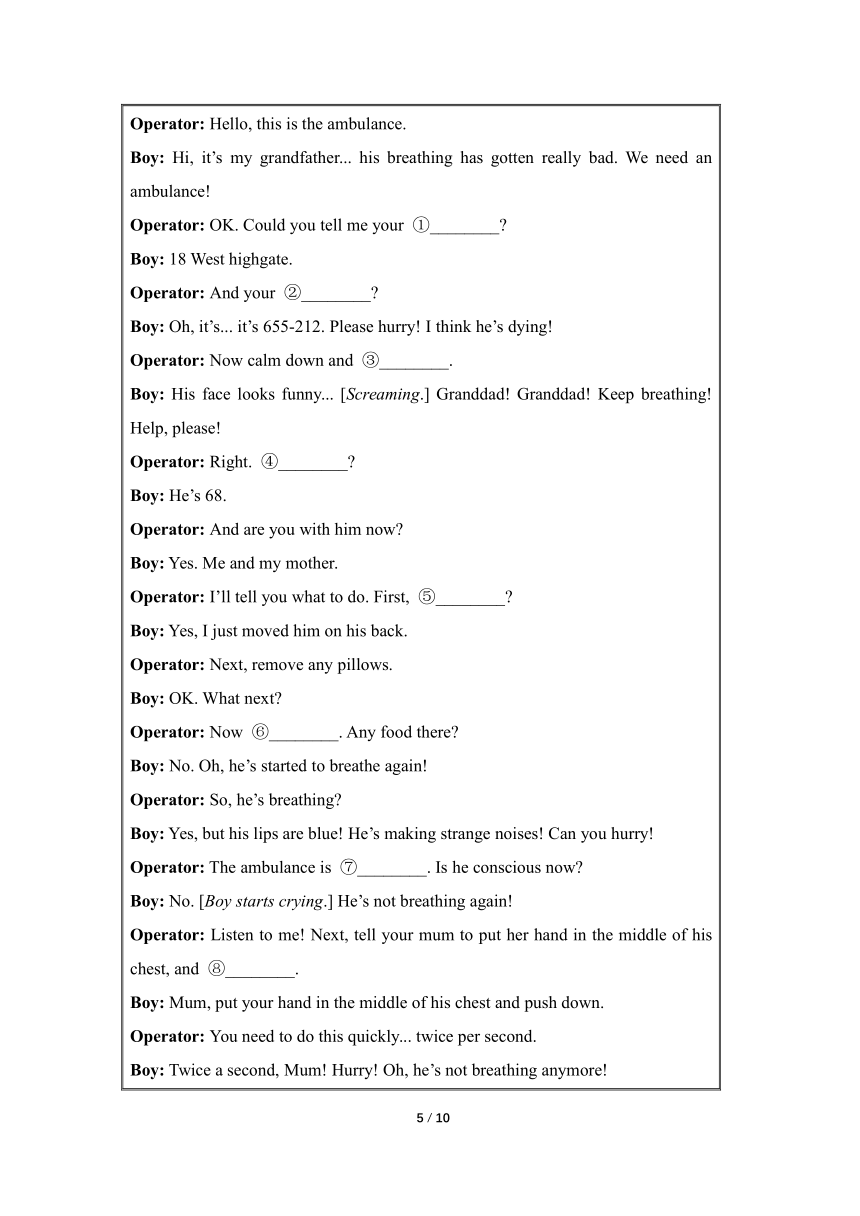
文档简介
Unit 5 Period Ⅳ Using Language(1) 名师教学设计
课时内容
Learn to call emergency services
主题语境:人与自然
主题群:灾害防范
子主题:安全常识和自我保护
语篇类型:听力、对话、图片
文本分析:
[What]本节课为听说课,学习拨打急救电话。首先学习世界范围内几个国家的急救电话,接着设置看图让学生识别几种不同突发疾病或事故的名称,并就如何拨打急救电话展开讨论,然后听一段关于拨打急救电话的对话,获取急救的指令、对病人进行急救等信息。最后分角色扮演模拟拨打急救电话的对话,学习发布急救的指令,内化语言,深化对主题的理解。
[Why]学习急救的指令语言,开展恰当的急救。
[How]将英语语用目标和本单元的主题语境结合起来,设置听说活动,让学生在主题语境的探索中提高英语运用能力,深入对主题的探究。
课时目标
1.掌握急救电话的特点和拨打急救电话的要求。
2.在日常生活中学会急救的方法,提高帮助他人的意识。
重点难点
重点:
1.获取听力中拨打急救电话的方式的信息。
2.识别急救电话的语言特征和注意事项。
难点:
在日常生活中实施急救的方法,提高帮助他人的意识。
教学准备
教师准备:
教学录音、关于急救的常识。
学生准备:
学习急救电话的语言。
教学过程
Step I 学习理解
活动一:感知与注意
1. Get to know about some emergency numbers.
Show students some emergency numbers and ask them to match the countries with the emergency numbers.
Suggested answers:
Australia: 000; Canada: 911; China: 120;
Japan: 119; Most European countries: 112; New Zealand: 111: South Korea: 119;
the UK: 999 and 112; the US: 911
2. Match and discuss
(1)Ask students to match the pictures below to the medical emergencies.
________ heart attack ________ drowning
________ sprained ankle ________ poisoning
________ bad cut/ bleeding
(2)Ask students to describe the situations.
Suggested answers:
①bad cut/bleeding
The photo of the bleeding leg shows a man in a construction worker uniform, with a big cut on his right leg. He seems to be awake, and able to move so it suggests that it is not an urgent emergency.
②sprained ankle
The woman is wrapping her hands around her right ankle and seems to be in some discomfort. She is sitting on the ground and I don’t think she can easily walk on that foot right now.
③poisoning
This photo shows a small child in a medicine cabinet. He is picking up a medicine. If he were to take the medicine, it would be very dangerous and potentially fatal.
④heart attack
This photo shows a man grasping the left side of his chest tightly. He might be struggling to breathe and dealing with a lot of pain. He should be seen by a doctor immediately.
⑤drowning
This photo shows a man in water struggling to keep above it. He might be drowning. Please send help!
(3)Ask students to discuss the questions.
·Have you ever called 120 If so, what happened
·Would you call 120 for the medical emergencies above How would you describe the situations
·What are some other medical emergencies that you would call 120 for
Suggested answers:
(略)
【设计意图】在听力之前,学习并讨论与主题相关的内容,有助于激活学生的相关认知,降低听力难度。
活动二:获取与梳理
1. Listen and fill.
Play the tape for students to listen to a 999 call in England and fill in the blanks.
Who: _____________ needs help. Age: ______________ The victim’s condition: ______________. Where: ______________
Suggested answers:
Who: A boy’s grandfather needs help.
Age: 68
The victims condition: His breathing has gotten really bad.
Where: 18 West Highgate
2. Listen and answer.
Play the tape for students again and ask them to answer the questions.
·Why did the boy call 999
·Who else was in the room with the boy and his grandfather
·How did the boy describe the old man’s condition
·Among the medical emergencies in Activity 2 on Page 54, which do you think the boy’s grandfather suffered from
Suggested answers:
·Because his grandfather was having a serious health problem and they needed an ambulance.
·The boy’s mother.
·“… his breathing has gotten really bad... I think he’s dying… His face looks funny... he’s started to breathe again... his lips are blue... He’s making strange noises… He’s not breathing again… he’s not breathing anymore!”
·Perhaps he suffered from a heart attack.
3. Note-taking.
Ask students to listen and take some notes.
Operator: Hello, this is the ambulance. Boy: Hi, it’s my grandfather... his breathing has gotten really bad. We need an ambulance! Operator: OK. Could you tell me your ①________ Boy: 18 West highgate. Operator: And your ②________ Boy: Oh, it’s... it’s 655-212. Please hurry! I think he’s dying! Operator: Now calm down and ③________. Boy: His face looks funny... [Screaming.] Granddad! Granddad! Keep breathing! Help, please! Operator: Right. ④________ Boy: He’s 68. Operator: And are you with him now Boy: Yes. Me and my mother. Operator: I’ll tell you what to do. First, ⑤________ Boy: Yes, I just moved him on his back. Operator: Next, remove any pillows. Boy: OK. What next Operator: Now ⑥________. Any food there Boy: No. Oh, he’s started to breathe again! Operator: So, he’s breathing Boy: Yes, but his lips are blue! He’s making strange noises! Can you hurry! Operator: The ambulance is ⑦________. Is he conscious now Boy: No. [Boy starts crying.] He’s not breathing again! Operator: Listen to me! Next, tell your mum to put her hand in the middle of his chest, and ⑧________. Boy: Mum, put your hand in the middle of his chest and push down. Operator: You need to do this quickly... twice per second. Boy: Twice a second, Mum! Hurry! Oh, he’s not breathing anymore! Operator:⑨________. The ambulance is on the way. Press the chest twice a second. Keep doing it. Boy: Keep doing it, Mum! Operator: I know it’s very tiring. If your mother needs ⑩________, you should change places. Boy: Please hurry up!... Oh, the ambulance is here! [Sound of a siren in the background.] Operator: I can hear them. I can hear them. Boy: Oh, thank you so much!
Suggested answers:
①address ②phone number
③tell me what’s wrong ④How old is he
⑤is he on his back ⑥look in his mouth
⑦on the way ⑧press down
⑨Just be calm and do what I tell you
⑩a break
4. Listen and number.
(1)Learning strategy.
Ask students to go through the sentences and make sure they understand their meanings.
Follow instructions
When giving commands, people usually use the imperative. It’s simple and clear. To help the listeners follow what to do next, they use words such as first, next, then, after that, and finally. When listening to instructions in English, you should
·listen carefully and don’t panic.
·follow the order of the instructions given to you.
·answer any questions simply and directly when asked.
(2)Play the tape for students to listen again and number the following instructions the operator gave.
________ Press down, twice a second.
________ Check to see if there is food in his mouth.
________ If your mother needs a break, change places.
________ Put him on his back.
________ Remove any pillows.
________ Tell your mum to put her hand in the middle of his chest.
Suggested answers:
5; 3; 6; 1; 2; 4
【设计意图】通过多次播放录音,学生获取听力材料的大意、具体细节信息并了解急救步骤。通过活动,学生获取和整合听力的细节内容,有助于单元主题意义的理解,也有利于口语活动的开展。
Step Ⅱ 应用实践
活动三:分析与判断
Ask students to work in groups and discuss the following questions.
·How did the operator keep the boy calm?
·What did the operator do to make this call a success?
·What do you think happened after the ambulance arrived?
Suggested answers:
·By telling him to calm down and calmly asking him questions.
·She asked only the questions necessary to clearly find out the problem, and then she provided short and clear instructions as to what to do.
·The doctors continued to provide CPR, took some blood pressure tests and temperature checking, while they transported him to the hospital.
活动四:描述与阐释
1. Describe the process of the first aid for drowning.
The pictures below show what to do to rescue someone from drowning. Talk about what is going on in each picture. Use the words given below.
Giving first-aid instructions for rescuing a drowning victim
lay the victim on his back check for a response call for an ambulance remove any grass or sand from his mouth perform mouth-to-mouth rescue breathing blow air in pat his shoulders check to see if he is breathing lift up his chin perform CPR cover his mouth push down on the centre of his chest
Suggested answers:
①OLay the victim on his back.
②Check for a response by patting his shoulders and calling him near each side of his ears.
③Call for an ambulance.
④Lift up his chin.
⑤Begin performing mouth-to-mouth rescue breathing: Blow air in his mouth until his chest rises.
⑥Perform CPR by pushing down on the centre of his chest, and then giving him mouth-to-mouth rescue breathing. Continue pushing on his chest and giving him mouth-to-mouth rescue breathing until help arrives.
2. Role-play an emergency call.
(1)Ask students to role-play an emergency call in pairs and one will be the friend of a drowning victim, and the other will be a telephone operator giving first-aid instructions.
(2)Ask students to pay attention to the following aspects.
Your tone:anxious but serious Questions:necessary Operator's instructions:short and clear
【设计意图】通过完成与听力材料有关的学习,提高学生对急救电话的认识和理解,然后用课本所给语言描述对溺水者实施急救的过程,最后通过开展角色扮演活动提高学生的语言表达能力。
Step Ⅲ 迁移与创新
活动五:想象与创造
Role-play an emergency call.
(1)Ask students to role-play an emergency call for burns according to the pictures and sentences given below.
Place burns under cool running water. Dry the burnt area gently. Remove any clothes near the burns using scissors. Cover the burnt area with a loose clean cloth.
(2)Make their role-play to the class.
【设计意图】在英语课堂教学中,设定特定的场景,让学生进行角色扮演活动,使学生在贴近现实的情景中学习,激发了学生主动学习的愿望,发展了学生的语言运用能力。
板书设计
Unit 5 First Aid Period Ⅳ Using Language(1) I.学习理解 活动一:感知与注意 1. Get to know about some emergency numbers. 2. Match and discus. 活动二:获取与梳理 1. Listen and fill. 2. Listen and answer. 3. Note-taking. 4. Listen and number. Ⅱ.应用实践 活动三:分析与判断 活动四:描述与阐释 Ⅲ.迁移创新 活动五:想象与创造 Role-play an emergency call.
2 / 2
课时内容
Learn to call emergency services
主题语境:人与自然
主题群:灾害防范
子主题:安全常识和自我保护
语篇类型:听力、对话、图片
文本分析:
[What]本节课为听说课,学习拨打急救电话。首先学习世界范围内几个国家的急救电话,接着设置看图让学生识别几种不同突发疾病或事故的名称,并就如何拨打急救电话展开讨论,然后听一段关于拨打急救电话的对话,获取急救的指令、对病人进行急救等信息。最后分角色扮演模拟拨打急救电话的对话,学习发布急救的指令,内化语言,深化对主题的理解。
[Why]学习急救的指令语言,开展恰当的急救。
[How]将英语语用目标和本单元的主题语境结合起来,设置听说活动,让学生在主题语境的探索中提高英语运用能力,深入对主题的探究。
课时目标
1.掌握急救电话的特点和拨打急救电话的要求。
2.在日常生活中学会急救的方法,提高帮助他人的意识。
重点难点
重点:
1.获取听力中拨打急救电话的方式的信息。
2.识别急救电话的语言特征和注意事项。
难点:
在日常生活中实施急救的方法,提高帮助他人的意识。
教学准备
教师准备:
教学录音、关于急救的常识。
学生准备:
学习急救电话的语言。
教学过程
Step I 学习理解
活动一:感知与注意
1. Get to know about some emergency numbers.
Show students some emergency numbers and ask them to match the countries with the emergency numbers.
Suggested answers:
Australia: 000; Canada: 911; China: 120;
Japan: 119; Most European countries: 112; New Zealand: 111: South Korea: 119;
the UK: 999 and 112; the US: 911
2. Match and discuss
(1)Ask students to match the pictures below to the medical emergencies.
________ heart attack ________ drowning
________ sprained ankle ________ poisoning
________ bad cut/ bleeding
(2)Ask students to describe the situations.
Suggested answers:
①bad cut/bleeding
The photo of the bleeding leg shows a man in a construction worker uniform, with a big cut on his right leg. He seems to be awake, and able to move so it suggests that it is not an urgent emergency.
②sprained ankle
The woman is wrapping her hands around her right ankle and seems to be in some discomfort. She is sitting on the ground and I don’t think she can easily walk on that foot right now.
③poisoning
This photo shows a small child in a medicine cabinet. He is picking up a medicine. If he were to take the medicine, it would be very dangerous and potentially fatal.
④heart attack
This photo shows a man grasping the left side of his chest tightly. He might be struggling to breathe and dealing with a lot of pain. He should be seen by a doctor immediately.
⑤drowning
This photo shows a man in water struggling to keep above it. He might be drowning. Please send help!
(3)Ask students to discuss the questions.
·Have you ever called 120 If so, what happened
·Would you call 120 for the medical emergencies above How would you describe the situations
·What are some other medical emergencies that you would call 120 for
Suggested answers:
(略)
【设计意图】在听力之前,学习并讨论与主题相关的内容,有助于激活学生的相关认知,降低听力难度。
活动二:获取与梳理
1. Listen and fill.
Play the tape for students to listen to a 999 call in England and fill in the blanks.
Who: _____________ needs help. Age: ______________ The victim’s condition: ______________. Where: ______________
Suggested answers:
Who: A boy’s grandfather needs help.
Age: 68
The victims condition: His breathing has gotten really bad.
Where: 18 West Highgate
2. Listen and answer.
Play the tape for students again and ask them to answer the questions.
·Why did the boy call 999
·Who else was in the room with the boy and his grandfather
·How did the boy describe the old man’s condition
·Among the medical emergencies in Activity 2 on Page 54, which do you think the boy’s grandfather suffered from
Suggested answers:
·Because his grandfather was having a serious health problem and they needed an ambulance.
·The boy’s mother.
·“… his breathing has gotten really bad... I think he’s dying… His face looks funny... he’s started to breathe again... his lips are blue... He’s making strange noises… He’s not breathing again… he’s not breathing anymore!”
·Perhaps he suffered from a heart attack.
3. Note-taking.
Ask students to listen and take some notes.
Operator: Hello, this is the ambulance. Boy: Hi, it’s my grandfather... his breathing has gotten really bad. We need an ambulance! Operator: OK. Could you tell me your ①________ Boy: 18 West highgate. Operator: And your ②________ Boy: Oh, it’s... it’s 655-212. Please hurry! I think he’s dying! Operator: Now calm down and ③________. Boy: His face looks funny... [Screaming.] Granddad! Granddad! Keep breathing! Help, please! Operator: Right. ④________ Boy: He’s 68. Operator: And are you with him now Boy: Yes. Me and my mother. Operator: I’ll tell you what to do. First, ⑤________ Boy: Yes, I just moved him on his back. Operator: Next, remove any pillows. Boy: OK. What next Operator: Now ⑥________. Any food there Boy: No. Oh, he’s started to breathe again! Operator: So, he’s breathing Boy: Yes, but his lips are blue! He’s making strange noises! Can you hurry! Operator: The ambulance is ⑦________. Is he conscious now Boy: No. [Boy starts crying.] He’s not breathing again! Operator: Listen to me! Next, tell your mum to put her hand in the middle of his chest, and ⑧________. Boy: Mum, put your hand in the middle of his chest and push down. Operator: You need to do this quickly... twice per second. Boy: Twice a second, Mum! Hurry! Oh, he’s not breathing anymore! Operator:⑨________. The ambulance is on the way. Press the chest twice a second. Keep doing it. Boy: Keep doing it, Mum! Operator: I know it’s very tiring. If your mother needs ⑩________, you should change places. Boy: Please hurry up!... Oh, the ambulance is here! [Sound of a siren in the background.] Operator: I can hear them. I can hear them. Boy: Oh, thank you so much!
Suggested answers:
①address ②phone number
③tell me what’s wrong ④How old is he
⑤is he on his back ⑥look in his mouth
⑦on the way ⑧press down
⑨Just be calm and do what I tell you
⑩a break
4. Listen and number.
(1)Learning strategy.
Ask students to go through the sentences and make sure they understand their meanings.
Follow instructions
When giving commands, people usually use the imperative. It’s simple and clear. To help the listeners follow what to do next, they use words such as first, next, then, after that, and finally. When listening to instructions in English, you should
·listen carefully and don’t panic.
·follow the order of the instructions given to you.
·answer any questions simply and directly when asked.
(2)Play the tape for students to listen again and number the following instructions the operator gave.
________ Press down, twice a second.
________ Check to see if there is food in his mouth.
________ If your mother needs a break, change places.
________ Put him on his back.
________ Remove any pillows.
________ Tell your mum to put her hand in the middle of his chest.
Suggested answers:
5; 3; 6; 1; 2; 4
【设计意图】通过多次播放录音,学生获取听力材料的大意、具体细节信息并了解急救步骤。通过活动,学生获取和整合听力的细节内容,有助于单元主题意义的理解,也有利于口语活动的开展。
Step Ⅱ 应用实践
活动三:分析与判断
Ask students to work in groups and discuss the following questions.
·How did the operator keep the boy calm?
·What did the operator do to make this call a success?
·What do you think happened after the ambulance arrived?
Suggested answers:
·By telling him to calm down and calmly asking him questions.
·She asked only the questions necessary to clearly find out the problem, and then she provided short and clear instructions as to what to do.
·The doctors continued to provide CPR, took some blood pressure tests and temperature checking, while they transported him to the hospital.
活动四:描述与阐释
1. Describe the process of the first aid for drowning.
The pictures below show what to do to rescue someone from drowning. Talk about what is going on in each picture. Use the words given below.
Giving first-aid instructions for rescuing a drowning victim
lay the victim on his back check for a response call for an ambulance remove any grass or sand from his mouth perform mouth-to-mouth rescue breathing blow air in pat his shoulders check to see if he is breathing lift up his chin perform CPR cover his mouth push down on the centre of his chest
Suggested answers:
①OLay the victim on his back.
②Check for a response by patting his shoulders and calling him near each side of his ears.
③Call for an ambulance.
④Lift up his chin.
⑤Begin performing mouth-to-mouth rescue breathing: Blow air in his mouth until his chest rises.
⑥Perform CPR by pushing down on the centre of his chest, and then giving him mouth-to-mouth rescue breathing. Continue pushing on his chest and giving him mouth-to-mouth rescue breathing until help arrives.
2. Role-play an emergency call.
(1)Ask students to role-play an emergency call in pairs and one will be the friend of a drowning victim, and the other will be a telephone operator giving first-aid instructions.
(2)Ask students to pay attention to the following aspects.
Your tone:anxious but serious Questions:necessary Operator's instructions:short and clear
【设计意图】通过完成与听力材料有关的学习,提高学生对急救电话的认识和理解,然后用课本所给语言描述对溺水者实施急救的过程,最后通过开展角色扮演活动提高学生的语言表达能力。
Step Ⅲ 迁移与创新
活动五:想象与创造
Role-play an emergency call.
(1)Ask students to role-play an emergency call for burns according to the pictures and sentences given below.
Place burns under cool running water. Dry the burnt area gently. Remove any clothes near the burns using scissors. Cover the burnt area with a loose clean cloth.
(2)Make their role-play to the class.
【设计意图】在英语课堂教学中,设定特定的场景,让学生进行角色扮演活动,使学生在贴近现实的情景中学习,激发了学生主动学习的愿望,发展了学生的语言运用能力。
板书设计
Unit 5 First Aid Period Ⅳ Using Language(1) I.学习理解 活动一:感知与注意 1. Get to know about some emergency numbers. 2. Match and discus. 活动二:获取与梳理 1. Listen and fill. 2. Listen and answer. 3. Note-taking. 4. Listen and number. Ⅱ.应用实践 活动三:分析与判断 活动四:描述与阐释 Ⅲ.迁移创新 活动五:想象与创造 Role-play an emergency call.
2 / 2
